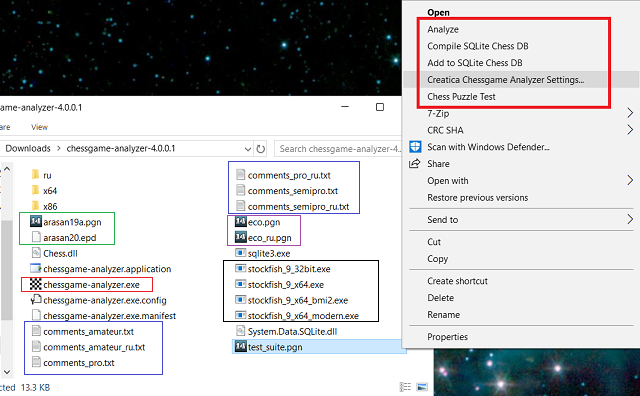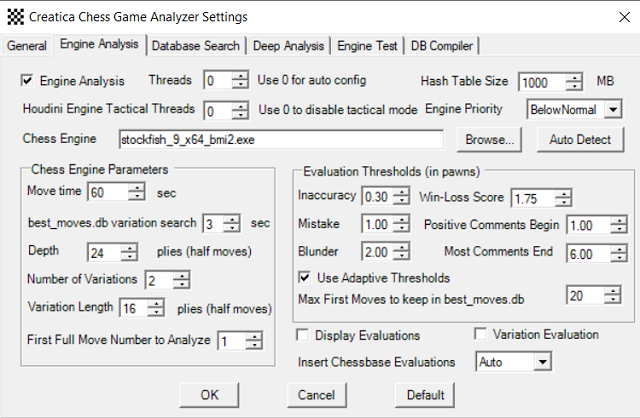Customization
The information below assumes that you have already downloaded and installed Creatica Chess Game Analyzer. If not, please go to Download or Install page.

Chess Game Analyzer version 4.0.0.0
Version 4.0.0.0 comes with GUI for settings. Just right click on any PGN or EPD file and select "Creatica Chess Game Analyzer Settings..."
Settings are divided in 6 groups. Each group of settings is located on its own tab.

General
General tab contains Language, file encoding, ECO and annotation template files as well as memory settings for SQLite. If you don't understand SQLite memory settings, please do not change them.If your PGN file includes many games, you can limit the number of games to display in the "Select Games" dialog box using "Max Number of First Games in PGN file to Display" parameter.

Engine Analysis
Most chess engine settings do not require an explanation. If you check "Use Adaptive Thresholds", then given threshold values for Inaccuracy, Mistake and Blunder will be increased proportionally by natural logarithm of position evaluation plus one. Some labels have hints. If you hold the mouse pointer over them, you may get additional information about particular setting. For example, if you hold the mouse over "Display Evaluation" label, then you will see a yellow rectangular filled with "Print evaluation to the console after a move".
Win-Loss Score means that when position evaluation reaches this threshold, the game can be considered the winning or the losing one. This score is used for win-to-lose and win-to-draw annotations. Deep Analysis also uses this parameter multipled by two. The engine will stop self-playing a game if its evaluation equals to doubled win-loss score.
Variation Evaluation allows you to get a position score at the end of a variation. Because the engine will spend extra time for it, the total analysis time may be doubled.
best_moves.db variation search time is the time that the chess engine will spend on building a variation for the known best move found in the SQLite database of best moves. best_moves.db is updated during each engine analysis. If the depth of the analysis is greater than the one found in the database, the best move, its depth and score will be updated. If the position is not yet known, then the new record will be inserted in the database, which includes position hash, best move, score and depth but excludes the variation. Prior to begin an analysis of a position, the program will search the database. If the position is found and the depth of it is equal or greater than the parameter Depth, then the best move will be taken from the database and the engine will search for a variation applicable to this move only. This is usually much faster than search for the best move from scratch. If the position is found but the depth is shallower than parameter Depth, then the engine analysis will be done as usual and the database record will be updated if the engine's reached depth is greater than the one in the record.
Max First Moves to Keep in best_moves.db means exactly what it says - the first configured full moves (more precisely, positions after each move) of a game will be kept in the database. The primary purpose of this database is to save time on engine analysis of popular chess openings.

Database Search
Database search is turned off by default because you need either to compile chess database yourself or to download mine. My database is built from KingBaseLite and is updated to 1/19. I used games with player Elo rating above 2300 and a difference in Elo rating between opponents not greater than 200. The database has only first 20 moves of those games. It is mainly used for searching statistically best continuations in openings.
Database can consist of 1, 2, 4 and 8 files. This is done for scalability and performance reasons. If you do not plan to use database, which is tens or hundreds of gigabytes, then one file is enough. My database is 799MB (compressed to 484MB for download).
If you check "Enable Evaluation of Database Variations by Chess Engine", then total analysis time will increase.
"Discard Rare Moves" means that if a move appears in less than 5 percent of all games in the databases for a given position, then skip it.

Deep Analysis
Deep analysis is new in version 4. The idea is to search for staticstically best move. If deep.db database does not have enough games, then a chess engine will play configured number of games with itself and when the games are finished will pick up the statistically best move. deep.db database has moves in UCI notation used by chess engines. KingBaseLite.db has moves in SAN notation. Therefore, these two databases are not compatable. This is done intentionally to keep human games separately from computer ones.
Deep analysis is off by default. Database deep.db is empty. The file does not exist but will be created when you enable it. Settings are chosen to do a relatively quick deep analysis, which may not be satisfactory to your taste. If you have powerful computer and ehough time, feel free to increase these parameters.

Engine Test
You may want to compare the ability of your chess engines to solve tactical tests. Chessgame-analyzer supports PGN and EPD formats. I only tested the program using Arasan Test Suite. Two files are included with the program: arasan19a.pgn and arasan20.epd.

DB Compiler
Chessdb-compiler.exe is now part of chessgame-analyzer.exe. If you do not plan to create gigantic databases of tens or hundreds of gigabytes, then one database file is enough. If you do not want to spend time building your own database, you may want to download mine. My database is built from KingBaseLite and is updated to 1/19. I used games with player Elo rating above 2300 and a difference in Elo rating between opponents not greater than 200. The database has only first 20 moves of those games. It is mainly used for searching statistically best continuations in openings.
